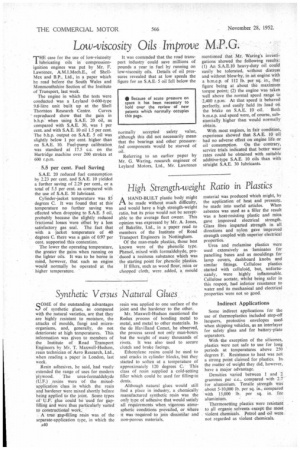Low-viscosity Oils Improve M.P.G.
Page 58

If you've noticed an error in this article please click here to report it so we can fix it.
THE case for the use of low-viscosity lubricating oils in compressionignition engines was put by Mr. F. Lawrence, A.M.I.Mech.E., of ShellMex and BP., Ltd., in a paper which he read before the Smith Wales and Monmouthshire Section of the Institute of Transport, last week.
The engine in which the tests were conducted was a Leyland 0-600-type 9.8-litre unit built up at the Shell Thornton Research Centre. Curves reproduced show that the gain in b.h.p when using S.A.E. 20 oil, as compared with S.A.E. 30, was 1 per cent. and with S.A.E. 10 oil 1.5 per cent. The b.h.p. output on S.A.E. 5 oil was slightly below 1 per cent. higher than on S.A.E. 10. Fuel-pump calibration was standard at 17.5 cc. on the Hartridge machine over 200 strokes at 600 r.p.m.
5.5 per cent. Fuel Saving
S.A.E. 20 reduced fuel consumption by 2.23 per cent. and S.A.E. 10 yielded a further saving of 2.29 per cent., or a total of 5.5 per cent. as compared with the use of S.A.E. 30 lubricant.
Cylinder-jacket temperature was 85 degrees C. It was found that at this temperature no further saving was effected when dropping to S.A.E. 5 oil, probably because the slightly reduced frictional losses were offset by a less satisfactory gas seal. The fact that with a jacket temperature of 40 degrees C. there was a gain of 0.97 per cent, supported this contention.
The lower the operating temperature, the greater the gains when running on the lighter oils. It was to be borne in mind, however, that such an engine would normally be operated at the higher temperature. normally accepted safety value, although this did not necessarily mean that the bearings and other pressurefed components would be starved of oil.
Referring to an earlier paper by Mr. G. Waring, research engineer of Leyland Motors, Ltd., Mr. Lawrence mentioned that Mr. Waring's investigations showed the following results: (1) An S.A.E.10 heavy-duty oil could easily be tolerated, without distress and without blow-by, in an engine with a b.rn.e.p. of 112 lb. per sq. in., that figure being at about the maximum torque point; (2) the engine was taken well above the normal speed range to 2,400 r.p.m. At that speed it behaved perfectly, and easily held its load on the brake on S.A.E. 10 oil. Both b.m.e.p. and speed were, of course, substantially higher than would normally obtain.
With most engines, in fair condition, experience showed that S.A.E. 10 oil had no adverse effect on engine life or oil consumption. On the contrary, service trials indicated that better wear rates could be obtained with suitable additive-type S.A.E. 10 oils than with straight S.A.E. 30 lubricants.




















































































